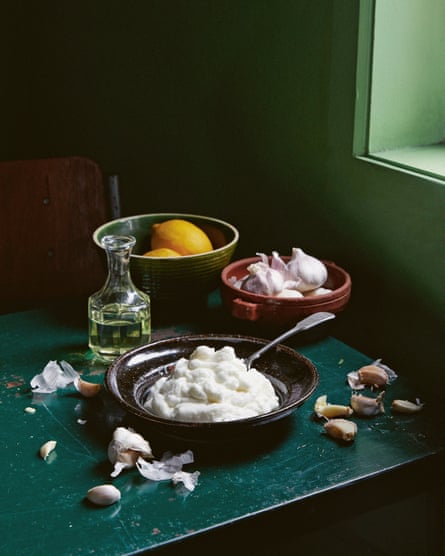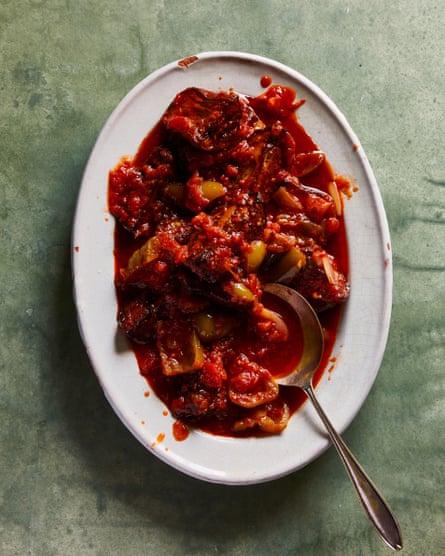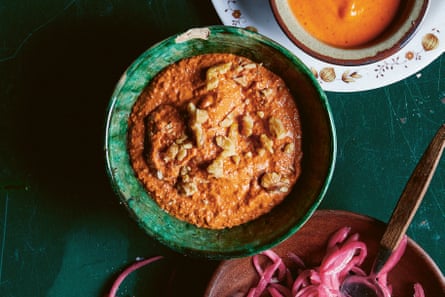
Summer koussa fattoush
(Pictured above)
At my Melbourne restaurant Rumi, we change our fattoush through the season. Although there is a “classic” Lebanese version, fattoush (as with panzanella) is a way to use up stale bread, so to me it made more sense to use salad ingredients at their best rather than obsessing about convention. The word “fattoush” derives from the action of tearing the bread. I was delighted (and a little disappointed because I thought it was my own bright idea) when I opened Samin Nosrat’s wonderful book Salt, Fat, Acid, Heat and found that she took the same approach with her seasonal panzanella salads.
Koussa is the name for the white Lebanese zucchini that is traditionally hollowed out and filled with rice and minced lamb. We use them here, barbecued, as the star of the salad.
Serves 4–6
50g dried chickpeas, soaked overnight
1 tsp sea salt, plus extra to taste
800g white zucchini
80ml extra-virgin olive oil (⅓ cup)
⅓ red onion, very finely sliced
5 cherry tomatoes
Juice of 1 lemon
½ bunch of flat-leaf parsley leaves, roughly chopped
10 mint leaves, torn
100g natural yoghurt
1 tbsp toum (see recipe below), or 2 finely crushed garlic cloves
2 flatbreads, cut into 3cm triangles and deep-fried or until crisp, or left whole and toasted in the oven
Ground sumac, for garnish and extra tang
Drain the chickpeas then place in a saucepan with plenty of cold water. Bring to the boil over a high heat, then reduce the heat to low and simmer for one hour, or until tender. Remove from the heat, stir in the salt, then leave to cool in the liquid.
While the chickpeas are cooling, preheat a charcoal barbecue. Cut the zucchini in half lengthways and place in a bowl. Add two tablespoons of the olive oil, season with salt and pepper and toss to coat well.
Chargrill the zucchini for five minutes on both sides, or until well caramelised, charred and soft in the centre. Transfer to a serving plate – preferably one with pictures of koussa painted on it – and season with salt, then set aside.
Place the onion and tomatoes in a small bowl and gently squash the tomatoes – their juices will become part of the dressing. Add the drained chickpeas, lemon juice, parsley, mint and the remaining olive oil. Season with salt and toss to combine well, then adjust to taste – it may need a little more lemon, salt or oil.
To serve, season the yoghurt with a pinch of salt and the toum or crushed garlic, and spoon over the zucchini. Add the fried bread (if you’ve toasted it whole, break it over the fattoush) and spoon the chickpea mixture over the top. Sprinkle with sumac and serve immediately.
Toum
The problem with toum is that you’ll find yourself using it everywhere, and everything you make ends up “needing toum”. If you’re not sure what toum is, it is the Arabic word for garlic as well as the paste that is a combination of garlic, oil, salt and lemon – almost like a thick garlic mayonnaise without egg.
Before making your toum, weigh your ingredients and refrigerate for a few hours until cold. Cool the blade of your blender or food processor too if that’s an option. Keeping everything cold like this will prevent your toum from splitting.
If your garlic is a little old and has a green shoot in the centre, split the clove and pick out the green shoot, as it can add an unwelcome bitterness.
Makes 600g
150g garlic cloves, peeled
8g salt
500ml canola oil (2 cups)
70ml lemon juice
Iced water (optional)
In a food processor, blitz the whole garlic cloves with the salt for 20–30 seconds.
With the motor still running, slowly add half the oil, as you would for mayonnaise, ensuring the mix does not split. This should take about two minutes.
With the motor still running, add half the lemon juice, then most of the remaining oil (this can be added a little faster). Add the remaining lemon juice, then the last of the oil. You can add a little iced water to make the toum fluffy, white and a little softer, if you like.
Store in an airtight container in the fridge for up to two weeks.
Eggplant m’nazleh

As I wrote my cookbook, I became aware of just how much my mother’s cooking had influenced me through osmosis, even though we never cooked together. Eggplant m’nazleh makes an appearance mostly during Lent, when many Lebanese Christians abstain from meat and dairy products. This is the one recipe that has found its way onto the Rumi menu that is truly my mother’s recipe. Well, as close to it as possible. We try.
This dish can be served hot but is most often eaten at room temperature. You can leave the peeled eggplant whole or cut in half for a more elegant presentation.
Serves 4
200ml extra-virgin olive oil
2 garlic cloves, thinly sliced
1 red chilli, deseeded and finely sliced
1 green chilli, deseeded and finely sliced
1 onion, cut into 3cm strips
1 green capsicum, cut into 5cm pieces
1 tsp salt
1 × 400 g tin chopped tomatoes
½ tsp baharat
Neutral oil, for shallow frying
2 eggplants, peeled and cut into large chunks about the size of a golf ball
In a large frypan over medium heat, gently heat the olive oil and fry the garlic and chillies until fragrant, but don’t allow them to colour. Add the onion, cover and sweat over a low heat until very soft, stirring occasionally.
Add the capsicum and salt and cook, covered, for about 30 minutes, until very soft.
Add the tomatoes and bring to the boil. (Stir all the way to the bottom of the pot to prevent it sticking.) Reduce the heat, cover, and simmer for two hours, or until the tomato has broken down and the oil has separated.
Stir in the baharat. Taste, and add more salt if needed.
In another large frypan, heat 2cm oil and fry the eggplant until brown all over. (Better still, use a deep-fryer.)
after newsletter promotion
Drain in a colander, set over a plate lined with paper towel, and season with a pinch of salt. Leave in the colander for around 10 minutes to allow any excess oil to drain away. Add to the sauce and simmer until the eggplant is very soft, then serve.
Circassian chicken

This dish is a version of the traditional Turkish dish made from shredded chicken, walnuts and paprika. Here, poached chicken is folded through muhammara. Circassian chicken should be served warm or at room temperature, not cold from the fridge.
Serves 4–6
2 skinless chicken breasts
500ml chicken stock (2 cups) , or salted water with 1 quartered onion
160g muhammara (see recipe below)
Crisp flatbread or sourdough toast, and pickles, to serve
Optional garnishes
10 walnut halves, roughly chopped
2 tablespoons salça butter (see recipe below)
Sprinkle of Turkish chilli powder
Sprinkle of nigella seeds
Place the chicken in a saucepan with the cold chicken stock or salted water with the onion and bring to the boil over a high heat. Reduce the heat to low and poach, uncovered, for approximately 15 minutes until just cooked. Remove the chicken from the liquid and let it cool.
When it is cool enough to handle, shred the chicken and place in a bowl. Add the muhammara and mix well. Spread on a plate or place in a bowl and top with one or all of the optional garnishes. Serve with crisp flatbread or sourdough toast, and pickles.
Muhammara

Muhammara has come and gone from Rumi’s repertoire over the years, and has appeared on everything from baked fish to barbecued beetroot. The sweet–sour pomegranate molasses is great with the red capsicums. You can leave out the walnuts if you have a nut allergy and this recipe will still give you joy.
Makes 500g
2 large red capsicums, or 280 g (10 oz) drained tinned roasted capsicum
120g walnuts
50g pomegranate molasses
2 tsp ground cumin
1 tsp Turkish chilli powder
1 tsp salt
120ml extra-virgin olive oil (½ cup)
If using fresh capsicums, char them over an open flame or gas barbecue. The skin should be black all over, which will make peeling them easier. Set aside in a colander to drain and cool. Once the capsicums are cool enough to handle, rub off the charred skins. Remove the stem and split the capsicum open to remove its seeds. Cut the flesh into bite-sized pieces to assist with blending.
In a blender or food processor, pulse the walnuts until they have a coarse, granola-like consistency. Remove half and add to a mixing bowl. (I do this because I like the idea of some crunch left in the mix, but I also like the fine walnuts to be one with the other ingredients.) Continue to blend the remaining walnuts until they resemble almond meal.
In the food processor, add the capsicum – either the fresh barbecued one, or the tinned, whatever you’re using – and remaining ingredients, except for the oil, and blend until smooth, stopping occasionally to scrape down the sides. With the motor running, add the oil slowly, so it combines with the capsicum. Transfer to the bowl with the coarse walnuts and combine well. I like to finish by stirring through a tablespoon of water, which makes it look creamier and more combined.
Store in an airtight container in the fridge for up to two weeks.
Salça butter
Turkish salça is a red paste similar in appearance to tomato paste, but made from dried capsicum. Salça butter is simply a combination of butter and salça that, when cooked together, creates a complex, umami-rich flavour.
Makes 360g
300g salted butter
60g salça (red pepper paste)
Melt the butter in a small saucepan over a medium heat. Whisk in the salça and cook over a low heat for about an hour, stirring occasionally. The butter should smell a little cheesy when it is ready. Remove from the heat and allow it to cool completely.

Once cool, transfer the butter to a container and seal. Stir the butter before it sets completely as the salça will sink. This butter will keep in the fridge for up to three months.



